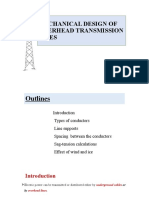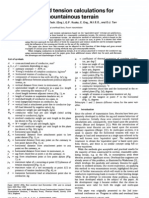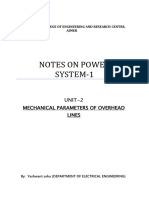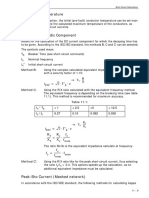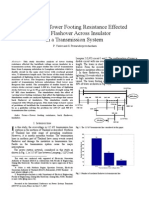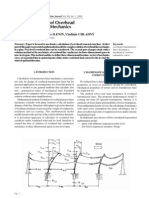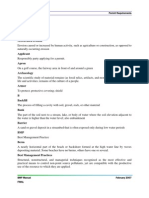App H
Uploaded by
Udomkarn SmtApp H
Uploaded by
Udomkarn SmtAppendix H Stringing Sag Calculations
Sag for Each Span Calculations
Stringing sags are derived by expanding spans within a ruling span so that tension in the sag span will be
representative of that in the ruling span. Catenary equations are used to calculate stringing sags. The specific
formula used is as follows :
D= a * COSH (B/a) - a
Where : H = Horizontal tension at center of span (Lbs, Kg, or N)
W = Conductor weight (Lb/Ft, Kg/M, or N/M)
B = l/2 span length, assume level supports (Feet or Meters)
D = Sag (Feet or Meters)
a = H /W (Feet or Meters), referred to as Catenary Constant
Horizontal tensions are by definition the same in all spans within a ruling span section. SAG10 calculates and
stores the horizontal tension for each temperature needed in constructing a stringing chart.
3rd Return Wave Calculations
The equation used for sagging by stopwatch is derived from the following 3 equations:
V= sqrt( Pg / W )
D= W*S*S
8P
F= S/V
Where : F = Time wave has traveled (Sec.) ; = T / 2C
V = Velocity of transverse wave (Ft/Sec.)
P = Tension (Lbs.)
W = Weight of conductor (Lb/Ft.)
S = Distance travelled by wave (Ft.)
D = Sag (Ft.)
g = 32.2 (Ft / Sec2)
These equations are combined to form the equation for determining the wave return time:
T= .99689 C sqrt( D )
Where: T = Time for C waves to return (Sec.) ; = 2 * F * C
C = Number of return waves
3rd Return Wave : T=6*F
5th Return Wave : T = 10 * F
You might also like
- Curves of Conductors Conformation: WL H WL ANo ratings yetCurves of Conductors Conformation: WL H WL A6 pages
- PTR - (Mech Design) ... Mechanical Design of Transmission LinesNo ratings yetPTR - (Mech Design) ... Mechanical Design of Transmission Lines50 pages
- Nomograph For Determining Level Span Equivalents of Non-Level Spans.No ratings yetNomograph For Determining Level Span Equivalents of Non-Level Spans.5 pages
- Mechanical Design of Overhead Transmission LinesNo ratings yetMechanical Design of Overhead Transmission Lines35 pages
- 2.0 The Catenary: 2.1 Catenary and Parabolic Solutions For Sag in Level Spans100% (1)2.0 The Catenary: 2.1 Catenary and Parabolic Solutions For Sag in Level Spans10 pages
- Analytial Method To Calculate Sag and TensionNo ratings yetAnalytial Method To Calculate Sag and Tension8 pages
- Mechanical Characteristics of Overhead LinesNo ratings yetMechanical Characteristics of Overhead Lines13 pages
- (RTDI) Sag and Tension Calculations For Mountainous Terrain100% (1)(RTDI) Sag and Tension Calculations For Mountainous Terrain8 pages
- Overhead Transmission Lines: Mechanical Design, Insulators, Electrical DesignNo ratings yetOverhead Transmission Lines: Mechanical Design, Insulators, Electrical Design16 pages
- Sag: Sag Is A Vertical Distance From The Horizontal Line Between The Tops of TheNo ratings yetSag: Sag Is A Vertical Distance From The Horizontal Line Between The Tops of The6 pages
- 110kv Sagtension Calculation 1 PDF FreeNo ratings yet110kv Sagtension Calculation 1 PDF Free13 pages
- Assessment of Cable Tension Using Vibration Based Methodologies For Wireless Structural Health MonitoringNo ratings yetAssessment of Cable Tension Using Vibration Based Methodologies For Wireless Structural Health Monitoring8 pages
- Analysis of Transmission Tower With Different ConfigurationNo ratings yetAnalysis of Transmission Tower With Different Configuration11 pages
- (Ij TX: Approximnately 0018-9510/85/0002-0366$01.00©No ratings yet(Ij TX: Approximnately 0018-9510/85/0002-0366$01.00©7 pages
- Ee413 Ehv and Uhv Ac Transmission Unit 4 MECHANICAL DESIGN OF LINES AND GROUNDINGNo ratings yetEe413 Ehv and Uhv Ac Transmission Unit 4 MECHANICAL DESIGN OF LINES AND GROUNDING27 pages
- ACSR Graphic Method For Sag Tension Calculations 1927 Varney 30pp100% (1)ACSR Graphic Method For Sag Tension Calculations 1927 Varney 30pp30 pages
- Navigation & Voyage Planning Companions: Navigation, Nautical Calculation & Passage Planning CompanionsFrom EverandNavigation & Voyage Planning Companions: Navigation, Nautical Calculation & Passage Planning CompanionsNo ratings yet
- Student Solutions Manual to Accompany Economic Dynamics in Discrete Time, secondeditionFrom EverandStudent Solutions Manual to Accompany Economic Dynamics in Discrete Time, secondedition4.5/5 (2)
- Hyrdoacoustic Ocean Exploration: Theories and Experimental ApplicationFrom EverandHyrdoacoustic Ocean Exploration: Theories and Experimental ApplicationNo ratings yet
- Design of Transmission Lines, Structures, and FoundationsNo ratings yetDesign of Transmission Lines, Structures, and Foundations8 pages
- Analysis of Tower Footing Resistance Effected Back Flashover Across Insulator in A Transmission System100% (1)Analysis of Tower Footing Resistance Effected Back Flashover Across Insulator in A Transmission System6 pages
- Solution Methods of Overhead Transmission Line Mechanics: Ladislav VARGA, Stanislav ILENIN, Vladimír CHLADNÝNo ratings yetSolution Methods of Overhead Transmission Line Mechanics: Ladislav VARGA, Stanislav ILENIN, Vladimír CHLADNÝ4 pages






